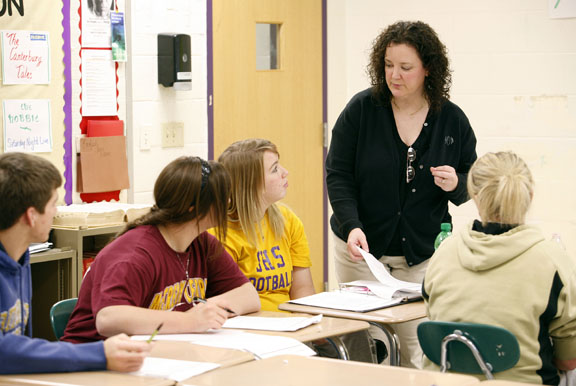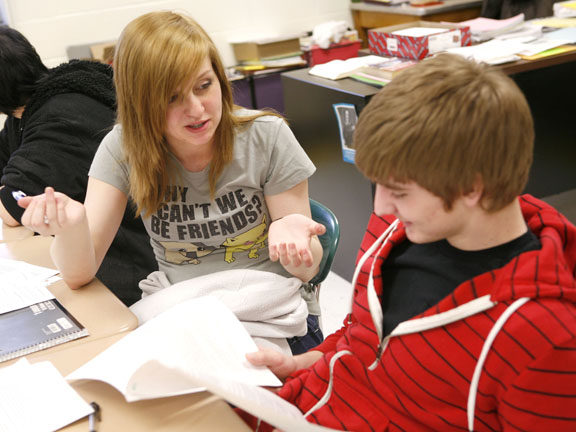
Jana Odom helps students with an assignment about origin stories during her English 4 transitional class at Somerset High School (Somerset Independent) March 10, 2011. Photo by Amy Wallot
By Susan Riddell
susan.riddell@education.ky.gov
Jana Odom, an English teacher at Somerset High School (Somerset Independent) said she feels more comfortable sending students off to college if they have participated in a transitional course while still in high school.
“This program enables students to develop skills they need for college work while remaining in the ‘safer’ environment of high school,” Odom said. “It is a frightening thing to enter a new phase of life. This fear is somewhat tempered when one knows what to expect. I feel better about sending these students to college knowing that they are more prepared for the expectations of undergraduate coursework.”
Transitional courses target high school seniors who scored just below readiness benchmarks for mathematics or reading on the ACT.These courses fall under the secondary intervention programs strategy identified to promote college- and career-readiness and degree completion following the passage of Senate Bill 1 in 2009.
Somerset High was one of several schools that piloted a reading transitional course during the 2009-10 school year. High schools worked with a nearby university to improve college- and career-readiness for these seniors.
This year, nearly 60 students at Somerset High are taking the reading transitional course.
At Rockcastle County High School, more than 55 students are finishing their first year of the school’s College Math Readiness transitional course. Both Rockcastle County and Somerset high schools have partnered with Eastern Kentucky University.
“The class gives students the opportunity to increase their math knowledge and readiness for college algebra,” said Scott Adams, who is in his 20th year of teaching mathematics at the school. “They will benefit from the opportunity to test out of remedial math courses and be able to enter credit-bearing classes immediately upon entering college. In addition, the class gives students a better idea of the structure and content of an entry-level college math class.”
Adams, who is mathematics department chair at his school, added that the number of students taking the readiness course will increase significantly since a mathematics elective will be a senior requirement next year.
College-bound students who don’t meet the ACT readiness benchmarks are required to take developmental courses once in college. Odom said these courses are expensive and carry zero credit hours on a student’s transcript.
That’s where the high school transitional courses come in. The courses conclude with an end-of-year exam. Students who pass this test – or retake the ACT meeting the benchmarks should qualify to take credit-bearing courses in college.
“The transition course is designed to prepare students in several ways,” Odom said.
In addition to equipping them to take English 101 at the college or university level, Odom described the reading course as practical.

Seniors Kayla York and James Quillen work together on an assignment about origin stories during Jana Odom’s English 4 transitional class at Somerset High School (Somerset Independent) March 10, 2011. Photo by Amy Wallot
“The real-world material we examine in class helps young people refocus on issues outside their own sphere. This is one of the keys to being college ready,” Odom said. “It is one of the great stepping stones to maturity. Most of us have heard that soon-to-be-trite term ‘globalism.’ In reality, students need to think on many different levels, from self to the world as one population.”
Recently, Odom had students read the essay “The Merits of Meritocracy” by David Brooks.
“A lively discussion ensued involving whether or not this present generation of teens has it better than their parents or grandparents (when they were teens),” Odom said. “There were advocates for both sides. Some details discussed were whether or not every child should make the team, age compression regarding the toys children today select and how technology has altered communication for better or worse.
“At the very least, it is imperative that students learn to respect others, even when they disagree,” Odom added. “Communication is an important facet of this respect. It is also important that students learn how to think through issues and take a stand. They need to be able to support that stand in a professional manner. This class works toward that.”
With the mathematical transition courses, Adams focuses a lot of class time not on new strategies but giving basic concepts extra review.
“We were able to go much more in-depth with rational functions in our College Math Readiness class than we normally do in our other high school math courses. There is a lot of satisfaction in seeing students achieve a target score on a placement exam (because of the extra time allotted to subject matter),” he said. “It was very rewarding to see their growth and excitement as they see the improvement they make from the beginning of the class until the end.”
Adams added that these courses are worthwhile because the typical student taking his mathematics readiness class is one who knows where he or she needs to be academically.
“At this age, students recognize through their prior test scores whether they meet benchmarks in mathematics,” he said. “When taking this class, students generally are very motivated and goal-oriented, working to achieve at a higher level.”
MORE INFO …
Jana Odom, jana.odom@somerset.kyschools.us, (606) 677-9453
Scott Adams, scott.adams@rockcastle.kyschools.us, (606) 256-4816



Leave A Comment